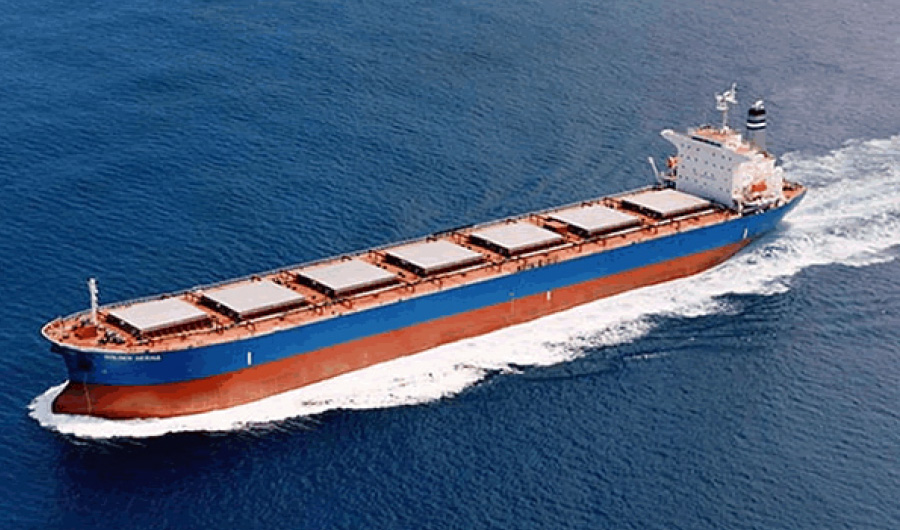Special Rudder
Ocean Fish Tail Rudder

Outline
“Fish Tail Rudders” which have been giving many excellent results up to now are categorized as a high lift special rudder, and mainly aimed at excellent maneuverability in port in such a manner that a forwarding component of a ship’s propulsive force can be reduced to zero when most suitably designed, with the rudder being turned up to 70 degrees.
On the other hand, ”Ocean Fish Tail Rudders” are designed for use in the area of ocean-going vessels, and mainly aimed at keeping ship’s good propulsive performance during ocean navigation; namely, Ocean Fish Tail Rudders are designed so that propulsive resistance can be equalized to or less than that of an ordinary rudder, and that ship’s maneuverability can be of a similar degree to that of ordinary Fish Tail Rudders.
As a result, an Ocean Fish Tail Rudder exhibits less propulsive resistance course keeping quality, course stability and safety as well as excellent inherent maneuverability in port.
Maximum helm angle of 45° is available for an Ocean Fish Tail Rudder. But incase that importance is attached to maneuvering in port, maximum helm angle of 70° is also available by request.
This is a proposal for introducing new design concept in the field of the conventional ordinary rudders.
Features

New Aerofoil Profile

Improved Progressive Performance (low drag coefficient)

-
Large Drag Force corresponding to Steering Angle

High lift force (high lift coefficient)

Improved Course Stability

Light weight and Low Cost
- New Aerofoil Profile(Fig.1)
-
Effects of tail angle, slope angle (including an element of foil thickness variation) and chord length will be examined by a tank test, and an aerofoil profile will be designed so that resistance can be equal to or less than that of an ordinary rudder.
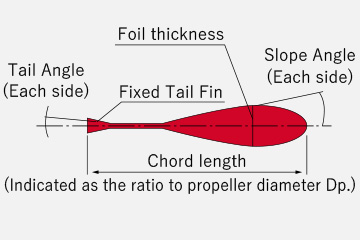
New Aerofoil Profile(Fig.1)
- Lift Coefficient(Fig.2)
-
The value of lift coefficient of an Ocean Fish Tail Rudders is about 40% higher than that of an ordinary rudder, and reaches the maximum at the rudder angle of about 45 degrees.
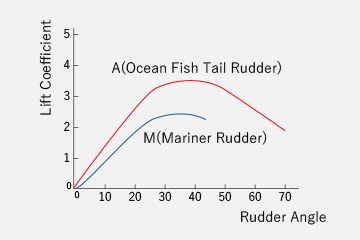
Lift Coefficient(Fig.2)
- Drag Coefficient (Resistance) (Fig.3)
-
When a rudder is nearly at the neutral position, which means that a ship is going straight, the value of drag coefficient (resistance) of an Ocean Fish Tail Rudder is less than that of an ordinary rudder.
On the contrary, the value of drag coefficient at the rudder angle of 35 degrees becomes 40% higher, and at the rudder angle of 45 degrees 80% higher, respectively, than that of an ordinary rudder at the rudder angle of 35 degrees. These high values of drag coefficient coupled with high lift coefficient display high maneuverability (steering ability).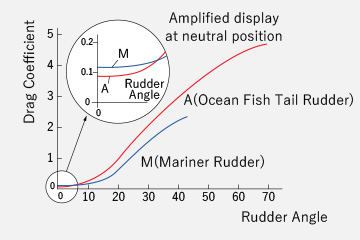
Drag Coefficient (Resistance)(Fig.3)
- High Steering Ability (Maneuverability)
By virtue of the increase in the values of drag coefficient and lift coefficient, high ship’s maneuverability is displayed at the rudder angle of about 45 degrees.
- Light weight and Low Cost
As an Ocean Fish Tail Rudder has more than 30% higher lift coefficient than that of an ordinary rudder, its weight becomes about 20 – 30% less than that of an ordinary rudder for the equivalent lift; thus reduction in cost can be attained.
Rudder Performance
Comparisons of rudder performance have been made between Ocean Fish Tail Rudders and ordinary rudders of Mariner Type by tank tests, simulation and on board actual vessels as follows:
- 60BC-Steady Turning Motion at Tank Tests
-
Ship Lpp(m)×B(m)×d(m) 219.00×32.20×12.19 Rudders Height(m) Width(m) Area(m2) Ocean Fish Tail 7.40 4.20 31.08 Mariner 8.00 4.90 39.20 The tank at Tokyo University of Mercantile Marine. An Ocean Fish Tail Rudder at 45 degrees angle shows remarkable superiority to a Mariner rudder at 35 degrees angle.
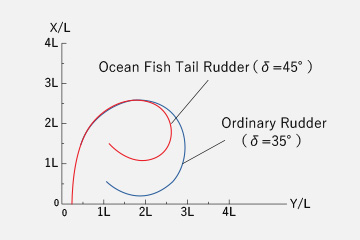
Steady Turning Motion of 60BC
- 75BC- Steady Turning Motion by Simulation
-
Ship Lpp(m)×B(m)×d(m) 217.00×32.20×13.82 Rudders Height(m) Width(m) Area(m2) Ocean Fish Tail 7.30 4.20 30.66 Mariner 8.00 4.90 39.20 The simulation was carried out at Hitachi Zosen Corp. An Ocean Fish Tail Rudder at 45 degrees angle showed remarkable superiority to a Mariner rudder.
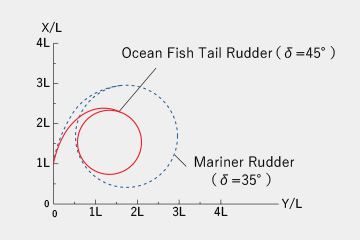
Steady Turning Motion 75BC
- Turning Movement at Sea Trial Ships
-
Ship Lpp(m)×B(m)×d(m) Gained Speed(kt) Ocean Fish Tail 108.00×19.60×7.85 15.82 Mariner 108.00×19.60×7.40 15.68 Rudders Height(m) Width(m) Area(m2) Ocean Fish Tail 4.50 2.60 11.70 Mariner 5.10 2.80 14.28 A comparison of the sea trial results between two Ro/Ro ships having similarity.
The ship with an Ocean Fish Tail Rudder gained higher ship’s speed and exhibited remarkably superior turning performance, compared with the ship with a Mariner rudder.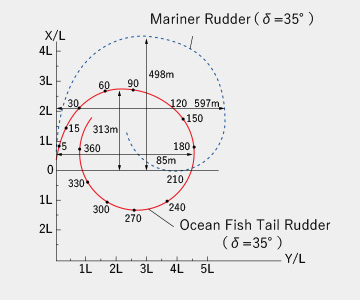
Steady Turning Motion of Actual Vessels
Maneuvering and Rudder Angles for Ocean Fish Tail Rudders
Depending on which one more importance is attached to, ocean-going performance or maneuverability in port, the following choices are prepared. No matter which choice is taken,Ocean Fish Tail Rudders will produce sufficient effects.
In designing Ocean Fish Tail Rudders, an optimum design is made per ship for rudder shape, rudder layout and a rotary vane type steering gear as an overall steering system conforming to desired ship’s operation.
- When importance is attached to ocean-going performance:
-
The maximum rudder angle of 45 degrees to port and starboard, respectively, is applied.
During ocean-going of a long distance, with an autopilot or a steering wheel being applied, propulsive performance is excellent in terms of course stability and course keeping quality, with propulsive resistance being equal to or less than that of an ordinary rudder.
In addition, maneuverability in an emergency and in port is much improved: an ability to brake a ship at its maximum rudder angle is remarkably higher than that of an ordinary rudder at its rudder angle of 35 degrees. This contributes to avoiding collision and improves safety.
- When importance is attached to operation in port:
-
The maximum rudder angle of 70 degrees to port and starboard, respectively, is applied.
With the rudder being taken to the maximum angle, ship’s forwarding thrust can be reduced to the utmost, and large side thrust is exhibited, thus resulting in more excellent maneuverability.
Comparison of Outfit on Board Vessel
The following drawings show a comparison of the rudder outfit on board vessel between an Ocean Fish Tail Rudder and an ordinary rudder:
| Ship’s Kind | DWT | Lpp×B×D×d(m) | SPEED(kt) |
|---|---|---|---|
| Chemical Tanker | 3,300DWT | 85.0×14.0×6.65×5.7 | 13.0 |
| Drawing of Outfit for Ocean Fish Tail Rudder | |
|---|---|
| Rudder Sizes[Height×Width](m) | 3.20×2.0 |
| Rotary Vane Steering Gear(t-m) | 9.6 |
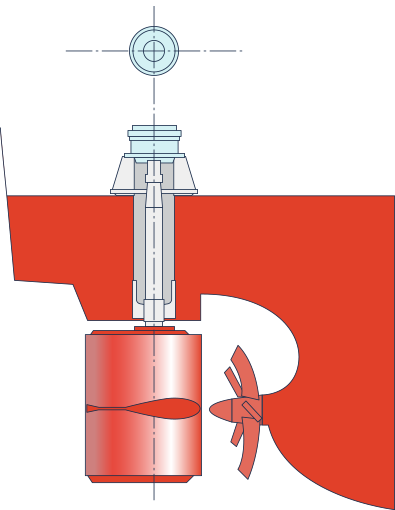 |
|
| Drawing of Outfit for Ordinary Rudder | |
|---|---|
| Rudder Sizes[Height×Width](m) | 3.35×2.6 |
| Piston Steering Gear(t-m) | 10.0 |
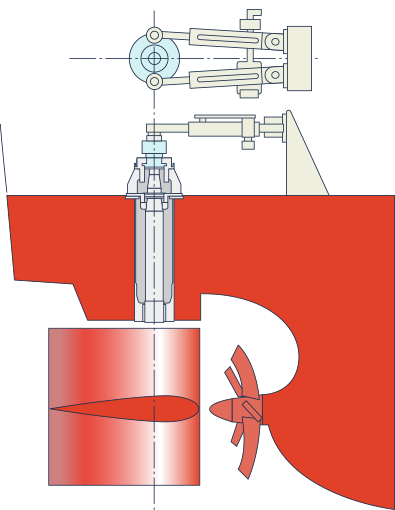 |
|
Delivery Records(Excerpts)
Ocean Fish Tail Rudders installed on board vessels are shown in the following table as excerpts.Special attention is drawn to the fact that an Ocean Fish Tail Rudder was applied to the 75,000 DWT Bulk Carrier.Further demands are anticipated after this.
| Ship’s kind | LPP(m) | DWT | Speed(kn) | Class |
|---|---|---|---|---|
| Bulk Carrier | 139.0 | 13,500 | 14.6 | NK |
| RO/RO | 150.0 | 5,316 | 22.0 | NK |
| PCC | 160.0 | 10,298 | 22.0 | NK |
| Product Tanker | 173.0 | 40,000 | 15.1 | AB |
| Chemical Tanker | 180.0 | 46,100 | 16.7 | NK |
| Bulk Carrier | 182.0 | 55,500 | 15.1 | NK |
| Container | 188.0 | 30,250 | 22.5 | BV |
| PCTC | 190.0 | 18,947 | 21.9 | NK |
| Bulk Carrier | 196.0 | 35,000 | 15.2 | DNV |
| Bulk Carrier | 216.00 | 72,700 | 15.7 | DNV |
| Bulk Carrier | 217.0 | 75,000 | 16.4 | AB |
| Tanker | 230.0 | 85,000 | 15.5 | AB |
